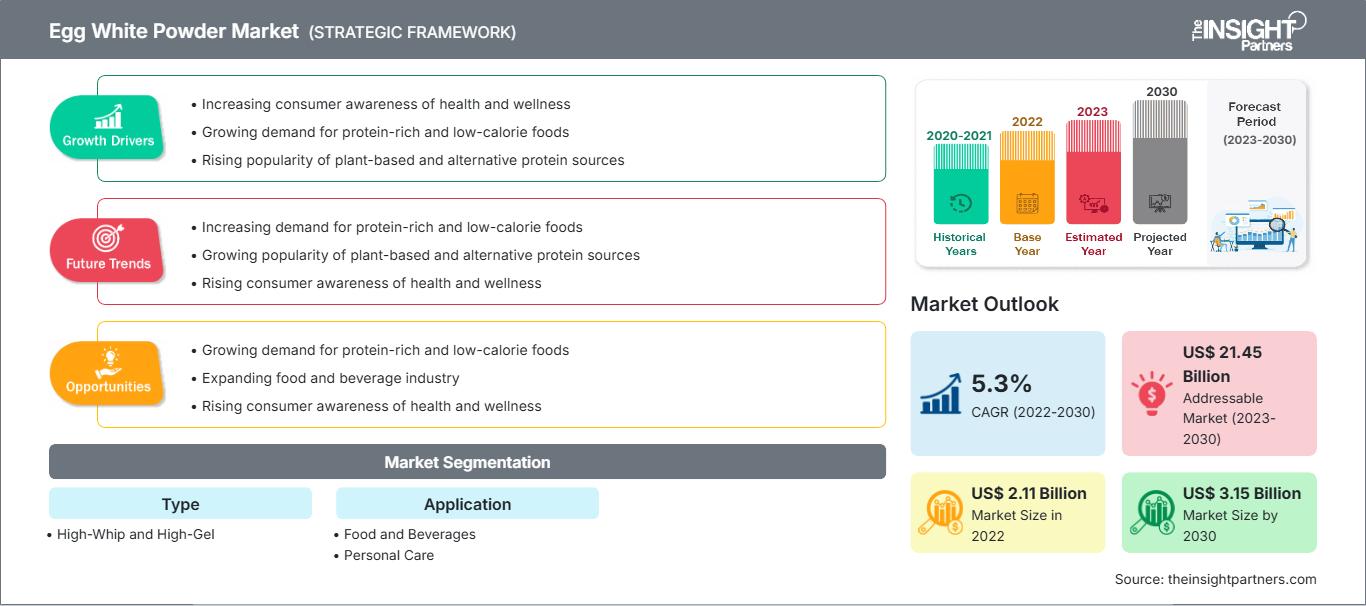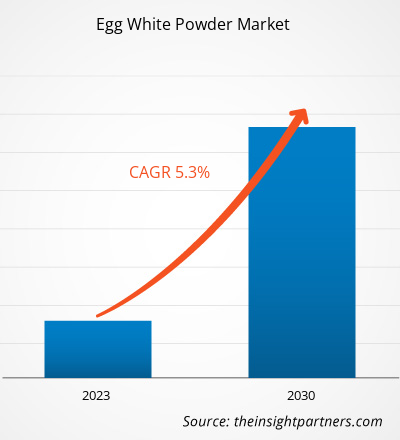[Forschungsbericht] Der Markt für Eiweißpulver wurde im Jahr 2022 auf 2.110,41 Millionen US-Dollar geschätzt und soll bis 2030 3.151,49 Millionen US-Dollar erreichen; von 2023 bis 2030 wird ein durchschnittliches jährliches Wachstum von 5,3 % erwartet.
Eiweißpulver hat eine gute Wasserbindungseigenschaft in verarbeitetem Fleisch, Meeresfrüchten, Backwaren und Süßwaren zur Verbesserung der Textur und Proteinanreicherung. Die Produkte können bei Raumtemperatur und trocken gelagert werden und haben im Vergleich zu Flüssigeiern eine lange Haltbarkeit. Aufgrund seiner schäumenden und gelierenden Eigenschaften wird Eiweißpulver als wichtige Lebensmittelzutat verwendet. Eiweißpulver hat in seiner rekonstituierten Form viele Anwendungen. Pulvereier sind bis zu 5–10 Jahre haltbar, wenn sie ohne Sauerstoff oder in einer kühlen Lagerumgebung gelagert werden. Es wird in Lebensmitteln eingesetzt, in denen nur Eiweiß erwünscht ist.
Im Jahr 2022 hatte Europa den größten Anteil am globalen Markt für Eiweißpulver, und der asiatisch-pazifische Raum wird im Prognosezeitraum voraussichtlich die höchste durchschnittliche jährliche Wachstumsrate verzeichnen. Der europäische Markt für Eiweißpulver ist in Deutschland, Frankreich, Italien, Großbritannien, Russland und das übrige Europa unterteilt. Der Markt für Eiweißpulver wird voraussichtlich aufgrund der Präsenz namhafter Akteure wie GEMPOL SP, Z OO, OVOBEST Eiprodukte GmbH & Co. KG, EISA-Sachsen GmbH und Merck KGaA in ganz Europa deutlich wachsen. Diese Unternehmen bedienen Märkte wie Tierfutter, Backwaren, Getränke und Süßwaren und verfügen über einen breiten Kundenstamm. Sie bieten auch verschiedene Eiweißpulver an, darunter High-Gel und High-Whip. Laut Agra CEASE Consulting verzeichnete die europäische Eierproduktionsindustrie im Jahr 2021 eine jährliche Produktion von 1.500.000 Tonnen Eierprodukten und hielt damit einen Anteil von etwa 41,7–44,3 %. Die Präsenz namhafter Branchenakteure und die massive Verarbeitung von Eiweiß fördern daher das Wachstum des Eiweißpulvermarktes. Das mit dem Eiweißpulver verbundene Kontaminationsrisiko und die Volatilität der Rohstoffpreise können das Wachstum des Eiweißpulvermarktes jedoch hemmen.
Passen Sie diesen Bericht Ihren Anforderungen an
Sie erhalten kostenlos Anpassungen an jedem Bericht, einschließlich Teilen dieses Berichts oder einer Analyse auf Länderebene, eines Excel-Datenpakets sowie tolle Angebote und Rabatte für Start-ups und Universitäten.
Markt für Eiweißpulver: Strategische Einblicke

-
Holen Sie sich die wichtigsten Markttrends aus diesem Bericht.Dieses KOSTENLOSE Beispiel umfasst Datenanalysen, die von Markttrends bis hin zu Schätzungen und Prognosen reichen.
Auswirkungen der COVID-19-Pandemie auf den Markt für Eiweißpulver
Die COVID-19-Pandemie hatte Auswirkungen auf Volkswirtschaften und Industrien in verschiedenen Ländern weltweit. Lockdowns, Reisebeschränkungen und Geschäftsschließungen in Nordamerika, Europa, im asiatisch-pazifischen Raum (APAC), in Süd- und Mittelamerika (SAM) sowie im Nahen Osten und Afrika (MEA) behinderten das Wachstum mehrerer Branchen, darunter der Lebensmittel- und Getränkeindustrie. Die Schließung von Produktionseinheiten störte globale Lieferketten, Fertigungsaktivitäten, Lieferpläne und den Verkauf verschiedener lebenswichtiger und nicht lebenswichtiger Produkte. Verschiedene Unternehmen kündigten mögliche Verzögerungen bei Produktlieferungen und einen Einbruch der zukünftigen Verkäufe ihrer Produkte im Jahr 2020 an. Zudem zwangen die von den Regierungen verschiedener Länder in Europa, Asien und Nordamerika verhängten Verbote für internationale Reisen die Unternehmen, ihre Kooperations- und Partnerschaftspläne vorübergehend einzustellen. All diese Faktoren behinderten die Lebensmittel- und Getränkeindustrie im Jahr 2020 und Anfang 2021, was das Wachstum verschiedener mit dieser Branche verbundener Märkte einschränkte.
Markteinblicke
Funktionale Vorteile von Eiweißpulver fördern das Wachstum des Eiweißpulvermarktes
Eiweißpulver wird in der Lebensmittelindustrie aufgrund seiner schäumenden, verdickenden, gelierenden, emulgierenden, färbenden und aromatisierenden Eigenschaften häufig als polyfunktionale Zutat verwendet. Diese Eigenschaften von Eiweißpulver tragen dazu bei, die organoleptischen und technologischen Eigenschaften verschiedener Lebensmittel zu verändern. Eier und Eiprodukte enthalten außerdem hochwertiges Eiweiß. Die Verwendung von Eiern und flüssigem Eiweiß in Lebensmitteln bringt jedoch einige Herausforderungen mit sich, wie z. B. begrenzte Haltbarkeit, Lagerungsprobleme, Bruch der Eier und Kontaminationsrisiko. Die funktionalen Vorteile von Eiweißpulver helfen daher, diese Herausforderungen zu meistern. Eiweißpulver ist im Allgemeinen gut verträglich und birgt ein geringeres Allergierisiko als andere Proteinquellen wie Milchprodukte oder Soja. Sprühgetrocknetes Eiweißpulver verlängert die Haltbarkeit des Endprodukts. Die Haltbarkeit von Eiweißpulver beträgt 18 Monate und kann bei ordnungsgemäßer Versiegelung sowie kühler und trockener Lagerung auf 5–10 Jahre verlängert werden; eine Kühlung ist nicht erforderlich. Im Vergleich zu Flüssigei benötigt das aus Eiweiß gewonnene Pulver weniger Lagerraum und ist einfacher zu handhaben und zu transportieren. Darüber hinaus wird durch die Verwendung von Eiweißpulver das Risiko von Bruch und Verschütten während der Lebensmittelverarbeitung eliminiert und das Risiko von Verunreinigungen und lebensmittelbedingten Krankheiten verringert. Im Vergleich zu Flüssigei oder rohen Eiern bietet es auch einen wirtschaftlichen Vorteil.
In der Backwarenindustrie wird Eiweißpulver zunehmend wegen seiner schäumenden und gelierenden Eigenschaften verwendet. Das Eiweißpulver wirkt als Schaumstabilisator und verleiht den Backwaren Textur. Süßwarenhersteller gelten als die einzigen Abnehmer von pfannengetrocknetem Eiweißpulver und verwenden es aufgrund seiner antikristallisierenden Eigenschaften bei der Herstellung von luftigen Süßwaren (wie Nougat). Aufgrund seiner gelierenden Eigenschaften wird dieses Pulver auch bei der Herstellung von Fleisch- und Fischprodukten wie Surimi verwendet. Darüber hinaus wird Eiweißpulver häufig zur Zubereitung einer Vielzahl von Desserts verwendet, darunter Schokoladenmousse und Baisers. Daher beflügeln die funktionalen Vorteile von Eiweißpulver den globalen Eiweißpulvermarkt.
Typbasierte Erkenntnisse
Basierend auf dem Typ wird der Markt für Eiweißpulver in schlagfestes und geliertes Eiweißpulver unterteilt. Das Segment des schlagfesten Eiweißpulvers hatte 2022 einen größeren Marktanteil; das Segment des gelierten Eiweißpulvers wird im Prognosezeitraum voraussichtlich schneller wachsen. Geliertes Eiweißpulver ist ein hellgelbes Pulver ohne Verunreinigungen und mit typischem Eigeruch. Es verfügt über gute Emulgier-, Gelier-, Aufschlag- und Wasserspeichereigenschaften. Dieses Produkt verleiht Fleischprodukten, Fischhackfleisch und Mehlprodukten Nährstoffe, Elastizität, Geschmack und verlängert die Haltbarkeit. Daher steigt die Nachfrage nach Fleischprodukten, Fischhackfleisch und Mehlprodukten, was sich voraussichtlich positiv auf das Wachstum des Eiweißpulvermarktes auswirken wird.
Anwendungsbasierte Erkenntnisse
Basierend auf der Anwendung ist der Eiweißpulvermarkt in Lebensmittel und Getränke, Körperpflege und Sonstiges segmentiert. Das Segment Lebensmittel und Getränke wird im Prognosezeitraum voraussichtlich die höchste durchschnittliche jährliche Wachstumsrate verzeichnen. Hühnereier sind ein wichtiger Rohstoff beim Backen. Eier bestehen aus drei Hauptbestandteilen: der Schale, dem Eiweiß und dem Eigelb. Eiweiß macht etwa 70 % des Flüssiggewichts eines Eis aus. Bei der Behandlung von Eiweiß bildet sich Schaum, und sein Volumen vergrößert sich um das 6- bis 8-fache. Eischaum verleiht Kuchenteigen Volumen und ist für die Herstellung von Biskuitkuchen unentbehrlich. Eiweißpulver wirkt in Backwaren als Teigverbesserer. Eiweißpulver wird häufig als Stabilisator verwendet, um Backwaren Textur zu verleihen. Es wird in der Backindustrie häufig aufgrund verschiedener Eigenschaften eingesetzt, wie z. B. der guten, stabilen Schaumbildung, die große Mengen Mehl oder Zucker tragen kann. Eiweißpulver bewirkt eine Emulgierung der Fette im Teig und verleiht Backwaren so eine glatte und cremige Textur.
Die wichtigsten Akteure auf dem Eiweißpulvermarkt sind Taiyo Kagaku Co Ltd, AgroEgg Pte Ltd, Egg Domain Pty Ltd, Netto Industria De Alimentos Ltda, OVODAN International AS, Ovostar Union NV, Parmovo Srl, Foodchem International Corp, Taj Agro International und Venky's (India) Ltd. Diese Unternehmen konzentrieren sich auf die Einführung neuer Produkte und die geografische Expansion, um die weltweit wachsende Verbrauchernachfrage zu befriedigen und ihr Produktangebot in Spezialportfolios zu erweitern. Sie verfügen über eine weitverbreitete globale Präsenz, die es ihnen ermöglicht, einen großen Kundenstamm zu bedienen und so ihren Marktanteil zu vergrößern.
Markt für Eiweißpulver
Die Analysten von The Insight Partners haben die regionalen Trends und Faktoren, die den Markt für Eiweißpulver im Prognosezeitraum beeinflussen, ausführlich erläutert. In diesem Abschnitt werden auch die Marktsegmente und die geografische Lage in Nordamerika, Europa, dem asiatisch-pazifischen Raum, dem Nahen Osten und Afrika sowie Süd- und Mittelamerika erörtert.Umfang des Marktberichts zu Eiweißpulver
| Berichtsattribut | Einzelheiten |
|---|---|
| Marktgröße in 2022 | US$ 2.11 Billion |
| Marktgröße nach 2030 | US$ 3.15 Billion |
| Globale CAGR (2022 - 2030) | 5.3% |
| Historische Daten | 2020-2021 |
| Prognosezeitraum | 2023-2030 |
| Abgedeckte Segmente |
By Typ
|
| Abgedeckte Regionen und Länder |
Nordamerika
|
| Marktführer und wichtige Unternehmensprofile |
|
Dichte der Marktteilnehmer für Eiweißpulver: Verständnis ihrer Auswirkungen auf die Geschäftsdynamik
Der Markt für Eiweißpulver wächst rasant, angetrieben von der steigenden Nachfrage der Endverbraucher aufgrund von Faktoren wie sich entwickelnden Verbraucherpräferenzen, technologischem Fortschritt und einem stärkeren Bewusstsein für die Produktvorteile. Mit steigender Nachfrage erweitern Unternehmen ihr Angebot, entwickeln Innovationen, um den Bedürfnissen der Verbraucher gerecht zu werden, und nutzen neue Trends, was das Marktwachstum weiter ankurbelt.

- Holen Sie sich die Markt für Eiweißpulver Übersicht der wichtigsten Akteure
Berichts-Spotlights
- Fortschreitende Trends auf dem Markt für Eiweißpulver, um Unternehmen bei der Entwicklung effektiver langfristiger Strategien zu unterstützen
- Geschäftswachstumsstrategien der Marktteilnehmer in Industrie- und Entwicklungsländern
- Quantitative Analyse des Marktes von 2020 bis 2030
- Schätzung der weltweiten Nachfrage nach Eiweißpulver
- Porters Fünf-Kräfte-Analyse zur Veranschaulichung der Wirksamkeit von Käufern und Lieferanten auf dem Eiweißpulvermarkt
- Jüngste Entwicklungen zum Verständnis des wettbewerbsorientierten Marktszenarios
- Markttrends und -aussichten sowie Wachstumstreiber und -hemmnisse auf dem Eiweißpulvermarkt
- Unterstützung im Entscheidungsprozess durch Hervorhebung von Marktstrategien, die das kommerzielle Interesse untermauern
- Die Größe des Eiweißpulvermarktes an verschiedenen Knotenpunkten
- Ein detaillierter Überblick und die Dynamik der Eiweißpulverbranche
- Größe des Eiweißpulvermarktes in verschiedenen Regionen mit vielversprechendem Wachstum Möglichkeiten
- Historische Analyse (2 Jahre), Basisjahr, Prognose (7 Jahre) mit CAGR
- PEST- und SWOT-Analyse
- Marktgröße Wert/Volumen – Global, Regional, Land
- Branchen- und Wettbewerbslandschaft
- Excel-Datensatz
Aktuelle Berichte
Verwandte Berichte
Erfahrungsberichte
Grund zum Kauf
- Fundierte Entscheidungsfindung
- Marktdynamik verstehen
- Wettbewerbsanalyse
- Kundeneinblicke
- Marktprognosen
- Risikominimierung
- Strategische Planung
- Investitionsbegründung
- Identifizierung neuer Märkte
- Verbesserung von Marketingstrategien
- Steigerung der Betriebseffizienz
- Anpassung an regulatorische Trends






















 Kostenlose Probe anfordern für - Markt für Eiweißpulver
Kostenlose Probe anfordern für - Markt für Eiweißpulver